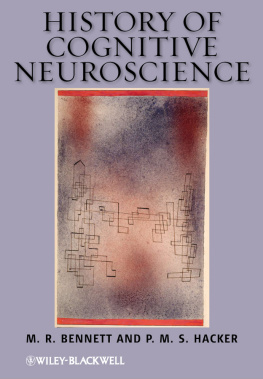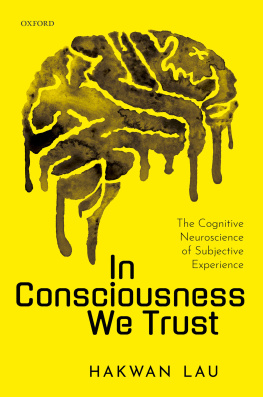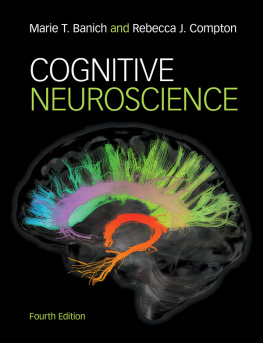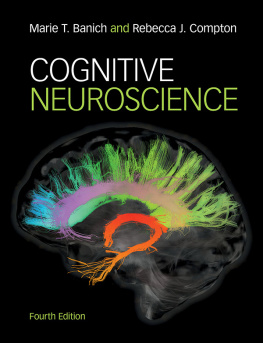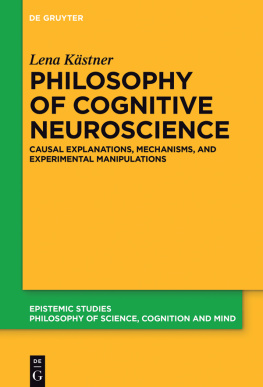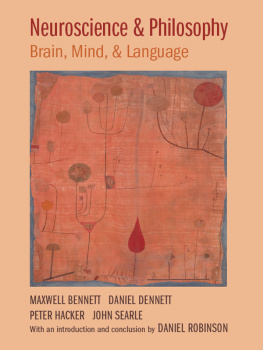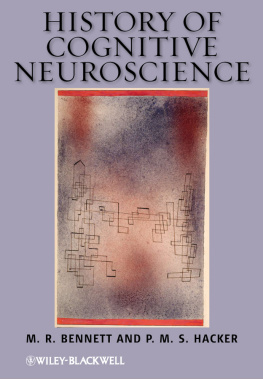Bennett M. R. Hacker P. M. S. - History of Cognitive Neuroscience
Here you can read online Bennett M. R. Hacker P. M. S. - History of Cognitive Neuroscience full text of the book (entire story) in english for free. Download pdf and epub, get meaning, cover and reviews about this ebook. year: 2012, publisher: Wiley, genre: Romance novel. Description of the work, (preface) as well as reviews are available. Best literature library LitArk.com created for fans of good reading and offers a wide selection of genres:
Romance novel
Science fiction
Adventure
Detective
Science
History
Home and family
Prose
Art
Politics
Computer
Non-fiction
Religion
Business
Children
Humor
Choose a favorite category and find really read worthwhile books. Enjoy immersion in the world of imagination, feel the emotions of the characters or learn something new for yourself, make an fascinating discovery.
- Book:History of Cognitive Neuroscience
- Author:
- Publisher:Wiley
- Genre:
- Year:2012
- Rating:3 / 5
- Favourites:Add to favourites
- Your mark:
- 60
- 1
- 2
- 3
- 4
- 5
History of Cognitive Neuroscience: summary, description and annotation
We offer to read an annotation, description, summary or preface (depends on what the author of the book "History of Cognitive Neuroscience" wrote himself). If you haven't found the necessary information about the book — write in the comments, we will try to find it.
History of Cognitive Neuroscience — read online for free the complete book (whole text) full work
Below is the text of the book, divided by pages. System saving the place of the last page read, allows you to conveniently read the book "History of Cognitive Neuroscience" online for free, without having to search again every time where you left off. Put a bookmark, and you can go to the page where you finished reading at any time.
Font size:
Interval:
Bookmark:

This paperback edition first published 2013
2013 M. R. Bennett and P. M. S. Hacker
Edition history: Blackwell Publishing Ltd (hardback, 2008)
Blackwell Publishing was acquired by John Wiley & Sons in February 2007. Blackwells publishing program has been merged with Wileys global Scientific, Technical, and Medical business to form Wiley-Blackwell.
Registered Office
John Wiley & Sons Ltd, The Atrium, Southern Gate, Chichester, West Sussex, PO19 8SQ, United Kingdom
Editorial Offices
350 Main Street, Malden, MA 02148-5020, USA
9600 Garsington Road, Oxford, OX4 2DQ, UK
The Atrium, Southern Gate, Chichester, West Sussex, PO19 8SQ, UK
For details of our global editorial offices, for customer services, and for information about how to apply for permission to reuse the copyright material in this book please see our website at www.wiley.com/wiley-blackwell.
The right of M. R. Bennett and P. M. S. Hacker to be identified as the authors of this work has been asserted in accordance with the Copyright, Designs and Patents Act 1988.
All rights reserved. No part of this publication may be reproduced, stored in a retrieval system, or transmitted, in any form or by any means, electronic, mechanical, photocopying, recording or otherwise, except as permitted by the UK Copyright, Designs and Patents Act 1988, without the prior permission of the publisher.
Wiley also publishes its books in a variety of electronic formats. Some content that appears in print may not be available in electronic books.
Designations used by companies to distinguish their products are often claimed as trademarks. All brand names and product names used in this book are trade names, service marks, trademarks or registered trademarks of their respective owners. The publisher is not associated with any product or vendor mentioned in this book. This publication is designed to provide accurate and authoritative information in regard to the subject matter covered. It is sold on the understanding that the publisher is not engaged in rendering professional services. If professional advice or other expert assistance is required, the services of a competent professional should be sought.
Library of Congress Cataloging-in-Publication Data
Bennett, M. R.
History of cognitive neuroscience / M.R. Bennett and P.M.S. Hacker.
p. ; cm.
Includes bibliographical references and index.
ISBN 978-1-4051-8182-2 (hardback : alk. paper) ISBN 978-1-1183-4634-1 (pbk. : alk. paper) 1. Cognitive neuroscienceHistory. I. Hacker, P. M. S. (Peter Michael Stephan) II. Title.
[DNLM: 1. Cognitive Sciencehistory. 2. Neuropsychologyhistory. 3. Brainphysiology. 4. Cognitionphysiology. WL 11.1 B472h 2008]
QP360.5.B463 2008
612.8233dc22
2008018526
A catalogue record for this book is available from the British Library.
Cover image: Paul Klee, Threatening Snowstorm, 1927, 291, pen and watercolour on paper on cardboard, 49.9 31.6 cm. Scottish National Gallery of Modern Art, Edinburgh, Vermchtnis Anna G. Blair. DACS 2008.
Cover design by Nicki Averill Design.
For Adam and David
List of Figures
Fig. 1.1 Helmholtz
Fig. 1.2 Helmholtzs argument on how a perception is formed
Fig. 1.3 The Kanizsa and Ponzo illusions
Fig. 1.4 The Adelbert Ames distorting room
Fig. 1.5 Ramachandrans bumps and hollows
Fig. 1.6 The phenomenon of filling in
Fig. 1.7 Rubins vase or two faces and Jastrows duck-rabbit
Fig. 1.8 Gestalt Laws of proximity, similarity and good continuation
Fig. 1.9 Techniques for observing behaviours of split-brain patients
Fig. 1.10 Axons have different functions in different parts of corpus callosum
Fig. 1.11 Brodmanns charts of convex and medial surface of cortex
Fig. 1.12 Neuronal orientation selectivity in primary visual cortex
Fig. 1.13 Ocular dominance columns in primate visual cortex
Fig. 1.14 Firing of neurons in inferior temporal cortex of a monkey in response to different images
Fig. 1.15 Random-dot stereogram
Fig. 1.16 Psychophysical experiments in conjunction with non-invasive brain imaging
Fig. 1.17 Shepard and Metzler-type drawings used in mental rotation experiments
Fig. 1.18 Synchronized neuronal firing of two different groups of cortical neurons
Fig. 1.19 Synchronized neuronal firing in three different groups of neurons in each hemisphere of the visual cortex of a cat
Fig. 1.20 Forward and backward projections to the primary visual cortex
Fig. 1.21 The stimuli used to determine the role of visual area 17 in visual imagery.
Fig. 1.22 Effects of transcranial magnetic stimulation on response times for imagery tasks
Fig. 2.1 Reconstruction by a subject of two speeches presented as mixed speeches
Fig. 2.2 Broadbents mechanism for selective auditory attention
Fig. 2.3 Treismans mechanism for detecting letter G in a display
Fig. 2.4 Reaction times of a subject for displays of different sizes
Fig. 2.5 Effect of brain stem stimulation on electrocortical activity
Fig. 2.6 Occipital potentials for subjects, in different arousal states, to flashes of light
Fig. 2.7 Auditory evoked potentials evoked by stimuli to each ear
Fig. 2.8 Effect of visual stimulus size and duration on choice by a subject with no V1
Fig. 2.9 Conscious and unconscious visual discrimination following lesions to primary visual cortex
Fig. 2.10 Firing of superior colliculus neurons in a monkey when a spot appears on a screen
Fig. 2.11 Experiments on the role of neurons in the superior colliculus
Fig. 2.12 Reaction times to detect a visual target after a parietal cortex lesion
Fig. 2.13 Enhancement of neuron firing in parietal cortex on detecting a dimming light
Fig. 2.14 Changes in firing of neurons in visual area V4 due to selective attention
Fig. 2.15 Identification of brain areas that generate the P3 auditory evoked response potential
Fig. 3.1 Lesions of the hippocampus show that it is required for memory in humans
Fig. 3.2 Classical conditioning of a defensive withdrawal reflex in Aplysia californica
Fig. 3.3 Discovery of neurons in the hippocampus that fire optimally when the rat is in a particular place
Fig. 3.4 Experiments that established the phenomenon of long-term potentiation (LTP)
Fig. 3.5 Experiments showing that NMDA receptors are involved in associative LTP
Fig. 3.6 Effects of polarization of neurons during stimulation on the generation of LTP
Fig. 3.7 Experiments showing that cAMP simulates late stages of LTP
Fig. 3.8 Experiments showing that AMPA are not involved in LTP
Fig. 4.1 Models of language systems in the cortex
Fig. 4.2 Wernickes theory of how aphasia arises
Fig. 4.3 Treismans theory of the operation of the mental dictionary and its units
Fig. 4.4 Mortons models for word recognition and speech recognition
Fig. 4.5 Mortons more recent logogen models for language
Fig. 4.6 Recent theories of speech
Fig. 4.7 Levelts theory for speech
Fig. 4.8 PET images of subjects when presented with four different sets of word-like stimuli
Fig. 4.9 PET images of subjects when presented with words and when speaking words
Fig. 4.10 PET images of patients with various kinds of damage
Fig. 4.11 Activity in different areas of temporal cortex accompanying perceiving animals or tools
Fig. 4.12 PET localization of active areas during certain movement types and the corresponding action words
Fig. 5.1 Types of feelings distinguished
Fig. 5.2 Types of affections distinguished
Next pageFont size:
Interval:
Bookmark:
Similar books «History of Cognitive Neuroscience»
Look at similar books to History of Cognitive Neuroscience. We have selected literature similar in name and meaning in the hope of providing readers with more options to find new, interesting, not yet read works.
Discussion, reviews of the book History of Cognitive Neuroscience and just readers' own opinions. Leave your comments, write what you think about the work, its meaning or the main characters. Specify what exactly you liked and what you didn't like, and why you think so.

